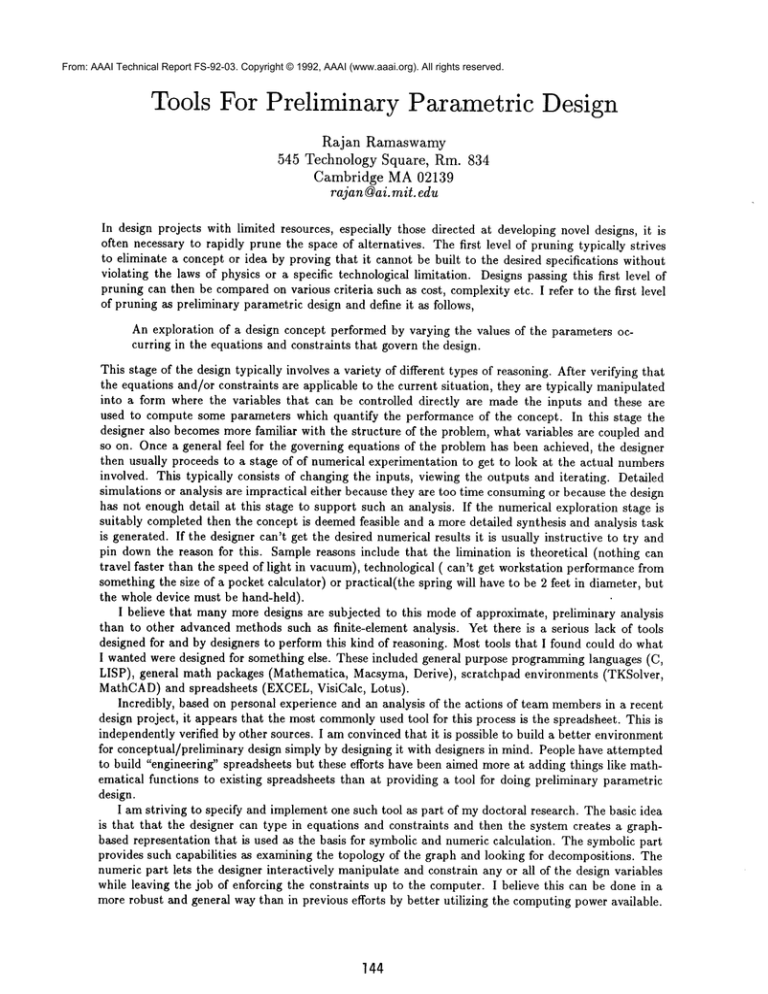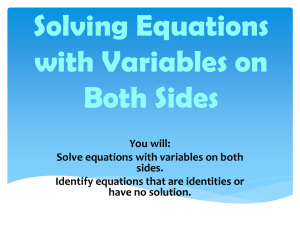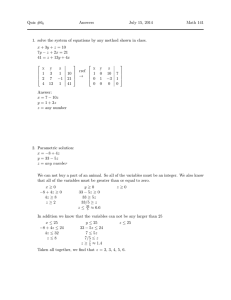
From: AAAI Technical Report FS-92-03. Copyright © 1992, AAAI (www.aaai.org). All rights reserved.
Tools For Preliminary Parametric Design
Rajan
Ramaswamy
545 Technology Square,
Rm. 834
Cambridge
MA 02139
rajah ~ai. mit. edu
In design projects with limited resources, especially those directed at developing novel designs, it is
often necessary to rapidly prune the space of alternatives. The first level of pruning typically strives
to eliminate a concept or idea by proving that it cannot be built to the desired specifications without
violating the laws of physics or a specific technological limitation. Designs passing this first level of
pruning can then be comparedon various criteria such as cost, complexity etc. I refer to the first level
of pruning as preliminary parametric design and define it as follows,
An exploration of a design concept performed by varying the values of the parameters occurring in the equations and constraints that govern the design.
This stage of the design typically involves a variety of different types of reasoning. After verifying that
the equations and/or constraints are applicable to the current situation, they are typically manipulated
into a form where the variables that can be controlled directly are made the inputs and these are
used to compute some parameters which quantify the performance of the concept. In this stage the
designer also becomes more familiar with the structure of the problem, what variables are coupled and
so on. Once a general feel for the governing equations of the problem has been achieved, the designer
then usually proceeds to a stage of of numerical experimentation to get to look at the actual numbers
involved. This typically consists of changing the inputs, viewing the outputs and iterating. Detailed
simulations or analysis are impractical either because they are too time consumingor because the design
has not enough detail at this stage to support such an analysis. If the numerical exploration stage is
suitably completed then the concept is deemed feasible and a more detailed synthesis and analysis task
is generated. If the designer can’t get the desired numerical results it is usually instructive to try and
pin down the reason for this. Sample reasons include that the limination is theoretical (nothing can
travel faster than the speed of light in vacuum), technological ( can’t get workstation performance from
something the size of a pocket calculator) or practical(the spring will have to be 2 feet in diameter, but
the whole device must be hand-held).
I believe that many more designs are subjected to this mode of approximate, preliminary analysis
than to other advanced methods such as finite-element analysis. Yet there is a serious lack of tools
designed for and by designers to perform this kind of reasoning. Most tools that I found could do what
I wanted were designed for something else. These included general purpose programming languages (C,
LISP), general math packages (Mathematica, Macsyma, Derive), scratchpad environments (TKSolver,
MathCAD)and spreadsheets (EXCEL, VisiCalc, Lotus).
Incredibly, based on personal experience and an analysis of the actions of team membersin a recent
design project, it appears that the most commonlyused tool for this process is the spreadsheet. This is
independently verified by other sources. I am convinced that it is possible to build a better environment
for conceptual/preliminary design simply by designing it with designers in mind. People have attempted
to build "engineering" spreadsheets but these efforts have been aimed more at adding things like mathematical functions to existing spreadsheets than at providing a tool for doing preliminary parametric
design.
I am striving to specify and implement one such tool as part of mydoctoral research. The basic idea
is that that the designer can type in equations and constraints and then the system creates a graphbased representation that is used as the basis for symbolic and numeric calculation. The symbolic part
provides such capabilities as examining the topology of the graph and looking for decompositions. The
numeric part lets the designer interactively manipulate and constrain any or all of the design variables
while leaving the job of enforcing the constraints up to the computer. I believe this can be done in a
more robust and general way than in previous efforts by better utilizing the computing power available.
144




